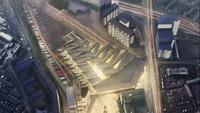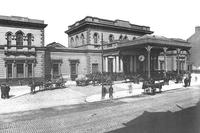Weaver's Loss
Each time I am reminded of what is coming to replace Great Victoria Street, I am dismayed. Here is the computer-rendered expectation:
This will be the building that welcomes visitors to Belfast after a long journey. Source.
This is a prime candidate for civic buildings that only look good in the architect's rendering. Note how clean the building looks in the renderings. The pure white and grey concrete slabs won't maintain that cleanliness without a huge maintenance cost. The artificial glow is just that; it exists only on a computer screen. It gives the rendering a false appearance of warmth, intended to evoke misleading feelings in the viewer. Feelings that traditional buildings evoke without CGI assistance.
The renderings also contain busy scenes, but I dispute that such a lifeless building will attract the admiration of so many people. The photograph's machine-generated crowds spoke to their intended audience; this rendering was designed solely to win a contract and impress planning committees on the council. Any other concerns or effects were discarded, if considered at all. Not to worry. I'm here to restate those concerns.
Towers talk
Why does any of this matter? Great buildings are the face of cities. Terminus buildings serve as introductions. They are landmarks, helping visitors find their way upon each visit. Perhaps this is why the terminus buildings of old had such detail and effort put into them, the railway companies in those days understood this: The station is where the beginning and ending of journeys happens. We want the building to signal great things ahead. Stability and surety for passage. A certainty that you've reached the journey's end.
Well built brick and stone convey this perfectly because they have properties shared with the goals of transport; stability and foresight. Flimsy glass and steel doesn't. To illustrate my point, look at these photographs of the old Great Victoria Street station, which stood proudly where the Europa Hotel now stands:
Tragically, this 1848 station was demolished in the 1970s due to a prejudice against rail in the government of that day. This combined with the effects of repeated Republican bombing to bring its sorry demise. Yet if Great Victoria Street station were preserved, it would be a landmark just as beloved and memorable as the Belfast City Hall. Such a picturesque building deserved a life well beyond the 1970s when it was demolished. More history here.
Notice how the stonework is built at a human scale, yet also serves as a welcome to a city well-footed in its past. The bricks would say: as we have continuity in this building so we have continuity of excellence in railway service. Transport is a foundation of civilisation and this carefully-crafted building was built by a confident civilisation. The human scale and detailing matters because it says to each individual passenger that you matter. We want to build for posterity, not something that will look shabby and dated in 10 years time. Also to instil a sense of civic pride that beautifies the city for inhabitants. The buildings should be something memorable and colloquial, something visitors will remember gladly. A building that will spring to mind some day later and make them wish to return.
The design for Weaver's Cross resembles an armadillo shell that was trodden into the ground. There is nothing in this design for Weaver's Cross that says unmistakably Belfast. Neither is there in the Europa Hotel building that replaced the original Great Victoria Street for that matter.
A suggested solution
Newcastle aren't taking care of their station. They've left it to become a Lydl. I propose we disassemble it and lift it to Great Victoria Street brick by brick. It would sit where the Europa Hotel now stands. Newcastle Station would certainly add a touch of character (even if the style is entirely misplaced) to an area much in need of it, the blandness only really broken by the Crown Bar and Grand Opera House.
Compare it to Ulster's other city, Londonderry. They recently reopened their old railway station. While the inner decor was heavily slanted modern, the exterior was preserved. Here, we have a compromise. The grandeur of the past met with the 'sleek efficiency' of the present. They've managed a compromise, they preserved and revitalised a great old building and brought it to the present. I don't want a compromise, but I'd take it over reckless destruction. Perhaps this speaks of a city in better touch with its past, and thus it has a firmer footing to face the future. Buildings should convey self-certainty. A hollow glass shell that could be erected anywhere conveys only insecurity, a desperation to be accepted by the 'in-crowd' who will immediately sense this and reject the vain effort.
Build for the wild
There are also some environmental arguments for building traditionally.
Glass-walled buildings are significantly harder to heat, cool and maintain compared to those they've replaced. Stone and windowed buildings are built using patterns that have been known for centuries, keeping them warm in winter and cool in summer simply by design. Locally-sourced materials anchor a building to its surrounding and require much less energy to transport and produce, compared to globally-sourced materials. These should matter more in an age where environmental concerns are supposedly foremost.
Calling Greenpeace and Extinction Rebellion, I've found a job for you. Please get the message out: Traditional is sustainable. You don't even need government funding, just build something that looks really nice, is locally-sourced and the local population will love it and take great care of it. Ignore the contractors and the architectural establishment. Which brings me on to the next point.
Build to belong
Great buildings surpass their original purpose. They grow with the towns. Consider the Scottish Provident Building in Belfast. This stately house was built in ages past as offices for an insurance company. Now they serve as office space for many smaller businesses, while the ground floor is host to many small businesses and even a bar. Or consider the old railway station at Portrush. When it had surpassed its purpose (debatably) in 1960 it wasn't demolished. Both buildings still stand as landmarks, still part of their locality, still making the fabric of their surroundings.
The future beckons
I write this knowing the plans are firmly on track, this is an express train making no stops. The conductor says it is too late to change. Yet my hope for the future is that Belfast might learn from Londonderry and regain its civic face. These modernist glass houses aren't built to last, so it is simply a case of waiting for Father Time to come for his dues.
Or, given the general state of our civilisation, perhaps we're getting the very building we deserve. Something lost, disjointed and transient. Something that can only impress in the virtual realm.
I leave you with a quote from Stephen Malkmus of eminent alternative rock group Pavement:
"Architecture students are like virgins with an itch they cannot scratch"
I think they want us to feel that same frustration when we see their buildings. Which other explanation is there?









